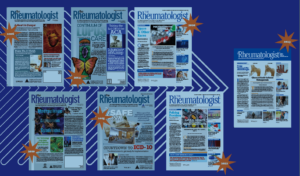 If you’ve been a long-time reader of The Rheumatologist, you may have noticed that things look just a little different in this issue. The logo has changed, the font appears distinct, and the bylines are, for lack of a better term, aligned differently. If you’re looking at this online, the menus have changed somewhat, and the background looks less like it was made in the 1990s. All of this resulted from the work of a large, interdisciplinary team over the course of a year. As a member of that team, I’ve been privileged to see how things are designed, often with a fine-toothed comb and a critical eye toward enhancing the reader experience.
If you’ve been a long-time reader of The Rheumatologist, you may have noticed that things look just a little different in this issue. The logo has changed, the font appears distinct, and the bylines are, for lack of a better term, aligned differently. If you’re looking at this online, the menus have changed somewhat, and the background looks less like it was made in the 1990s. All of this resulted from the work of a large, interdisciplinary team over the course of a year. As a member of that team, I’ve been privileged to see how things are designed, often with a fine-toothed comb and a critical eye toward enhancing the reader experience.
Throughout this process, I’ve been impressed by the thought that the world around is a product of what we design it to be. It’s not only fonts and figures that are crafted—often meticulously—but the entire scope of our civilization. Even as I drive around my home of Iowa City, I see products of design, such as the tiny details on roadside signs and elegant curves on the guardrails. As I open my laptop, I see the personable “We’re working on updates” screen, followed by a desktop full of eye-catching icons. And, in my own clinic, I’m suddenly observing the patterns on the carpet that gently steer people to their rooms and the lighting schema that seems to make things look calmer.
All of these things have made me dive deep into the art and science of design, and prompted me to explore an entirely underutilized paradigm of clinical science: the design-thinking process. How can these insights be specifically applied to the world of rheumatology? Let’s rheuminate.
A Quick Primer
Design thinking seems to have started in the 1940s, based on the nascent science of organizational behavior and psychology.1 In particular, psychologists started to focus on creativity and how creativity can be fostered to solve real-world problems.
Hybridizing with many other fields, such as architecture, engineering, computer science, marketing, anthropology and philosophy, design thinking began to seep in the world of business management. It became “a method of creative action.”2 Design thinkers pioneered and elaborated on several concepts that seem embedded into our everyday world today—things like ergonomics, wicked problems and brainstorming. It also introduced irksome jargon, terms that have lost much of their original meanings, such as think outside the box, touch base, paradigm shift and synergy.3
In any case, design thinking was influential in clarifying a mindset for thinking about user and customer experiences called human-centered design (HCD).4 In HCD, the process is focused on improving the user experience and usability. A great deal of variability in the theoretical underpinnings and practical applications of HCD remains, but broadly, HCD focuses on three steps—inspiration, ideation and implementation. In these three steps, there is convergent and divergent thinking, in which new ideas are generated and are then winnowed to get toward a solution.
As we’ve been redesigning The Rheumatologist, we’ve been adopting the process of design thinking and the mindset of HCD. We have nestled the three steps of HCD into the five, non-linear stages of design thinking (i.e., empathize, define, ideate, prototype and test).5 In the process, we’ve challenged assumptions and conventions to serve you better.
But how does this work in a busy rheumatology clinic? I am a relative newcomer to design thinking, but I would contend that all healthcare team members are designers at heart and that, at a very deep level, we instinctively understand the principles of design thinking and human-centered design, even if we don’t know the lingo.
Empathize: The First Duty of the Physician
Sir William Osler, the 19th century pioneer of American medicine, once counseled his trainees to “Listen to your patient; he is telling you the diagnosis.”6 Although many things Dr. Osler said and did have aged poorly—even the rather presumptive “he” in this quote—his advice is worthy of meditation. After all, what Dr. Osler is getting at is empathy. Listening to patients and truly trying to understand their circumstances in the context of their disease is the ideal goal of any healthcare team member. The same is true for design thinking. Empathy is the core and essential first stage in design thinking.
Arguably, empathizing is the hidden part of the iceberg in all our interactions. In this context, empathy means more than having the ability to understand another’s feelings. Empathy here refers to a deep understanding of another person, their wants, needs and objectives. Good clinicians, like good designers, are interested in not only matters of the mind, but also issues of the heart. What makes us feel this way or that way? Which assumptions are worthy of examining and reexamining? Can we find points of similarity and difference in lived experiences?
Conventional ways of understanding patients (or people in general) have employed surveys. They remain a mainstay of understanding sentiment. An extensive science, backed by psychometric data, shows the important role of surveys in characterizing those we serve. And yet, these numbers, comforting as they are, do not help us truly empathize because they reduce people to a set of mostly noninteracting, nondimensional scales. And that’s not even taking into account poorly made surveys whose results are as questionable as their questions.7
A newer approach has been to incorporate focus groups or interviews. While this seems to be a better approach, qualitative research can be technically more challenging and less generalizable.8 With little clarity about the optimal way to understand patients, the best approach is to do what good clinicians do: establish rapport and reduce power differentials to get a more authentic slice of life. Collaborative involvement as equal partners rather than as subjects may be the best way forward.
Defining or Diagnosing?
As Dr. Osler noted in the quote above, listening to patients is important to derive a diagnosis. The designer views empathy in a similar vein. Empathy is part of the convergent and divergent elements of design thinking and HCD. And with the divergence of ideas stemming from empathy comes the convergence during the define stage.9 Like a diagnosis, the pith of the define phase is to frame one problem the design may help address. By identifying and framing the core problem that is leading to dysfunction, we can all get around a strategy to find a solution to that problem.
Necessarily, in the define stage, we have to figure out what the scope of the issue is.10 When it came to The Rheumatologist, our scope was fairly broad. While we couldn’t change the size of the paper or the URL address, we had broad scope to change much so that readers could better digest the information and interface with the various elements of the publication.
In clinic, we have to often toggle our minds between diagnosis and define. Although it is important for us to label a condition as a diagnosis, it often does not define what a patient’s real concern may be. With respect to a rheumatic condition, a diagnosis can be an affirming and positive step, but only when we define the issue at hand. If we think about the patient’s concerns from a more holistic standpoint, incorporating socioeconomic determinants of health and other aspects of their experience, the diagnosis may appear to be only part and parcel of a larger issue requiring definition. This has important ramifications because, while defining is a convergent process, the next step in the design-thinking process is far more divergent.
Ideation: Beyond the Possibilities
The reason for defining or diagnosing an issue is that, once all those observations from the empathy stage are coalesced into a single issue, we are collectively tasked with coming up with ideas about how to proceed. That’s the fun part, at least when it came to redesigning The Rheumatologist. We think about ideation, whether in the clinic or in other settings, as being a hectic, anarchic enterprise. But ideation has a certain structure and form that can be utilized to benefit patients and users in general.
Ideation, in its broadest term, rests upon creative potential and imagination. In the clinic, I think about ideation as the delight seen in the eyes of a young medical student when they come up with a differential diagnosis. And, much like that list of medical student differential diagnoses, there are no true wrong answers here. Rather, the ideas emerge because they are tethered to the findings of the empathy and define phases. In truth, we could have an entire Rheuminations column on the creative thinking process of rheumatologists, but in this column, let me focus on two techniques that I absolutely adore and that I’d recommend you use in clinical settings. The first is “worst possible idea”—where the absolute silliest and most ridiculous ideas (or diagnoses) are entertained to challenge what makes a good idea (or diagnosis). Sometimes, what appears to be the worst idea may actually be revisited and turn out to be the best.
The other is to analogize. Because we consolidate our knowledge of the world into analogies and metaphors, the analogizing technique may be useful in clarifying why we are thinking the way that we are thinking—and to draw new ideas based on that insight.
Prototyping—Getting a Plan Together
One of the greatest joys in redesigning The Rheumatologist was seeing the huge numbers of prototypes. We incorporated all sorts of ideas into mock-ups. Different colors, fonts, menus, even capitalization schemes—they all made The Rheumatologist seem fresh and distinguished. Choosing between all of them was extraordinarily difficult, but I’m glad we had the opportunity to mix and match elements of each prototype together to get this lovely final product.
When it comes to the clinic, the prototype is somewhat limited, but there’s still a very good parallel. I think about medications and therapies as elements of a larger prototype therapeutic plan. As prototypes and treatment plans develop, we start with hazy outlines of what to do and then sharpen them up until they come to fruition.
As designers in the clinical setting, we have to constantly be aware of the consequences of poor prototyping. If we didn’t ideate widely and collaboratively enough to come up with enough prototypes, all the work previously done is for naught.
Testing (or Is It Treating?)
The last step in the design-thinking process is the one most often seen—testing. Testing in the design-thinking sense involves deploying the prototypes to understand how they would be adopted. Unlike classical thinking about tests with failures or successes, testing in this context is more like probing to understand how prototypes can be improved upon and how the lives of our users (or patients) can be positively impacted. For The Rheumatologist, it was printing out as many prototypes as possible and putting the printouts before readers and getting their opinions on what worked and what didn’t.
In our clinical settings, testing can best be thought of as follow-up to initiating a treatment. The real test is in knowing whether a medication or other therapy is having its intended main effect while reducing its side effects. Key to our understanding of any therapy is that there is no guarantee of its success—only a likelihood of success or not. To expand upon that a little, testing means critically listening to patients to identify what elements of the prototype have to be modified for it to work—or if we have to consider another form of prototype altogether.
This brings us back to the beginning—because design-thinking never really ends. In fact, even as soon as this redesign of The Rheumatologist is tested and implemented, we’ll continue to listen to you, our readers, and restart this cycle with deep empathy. Perhaps in the next incarnation of the redesign process, elements will change further, or remain the same, or perhaps even revert to how it was before. That’s the great thing about design—without the infusion of empathy at all stages of the process, it doesn’t quite work.
Love of The Rheumatologist
There we have it—the five stages of design thinking: empathize, define, ideate, prototype and test. We see and encounter these stages all around us, but they are so subtle we often don’t even notice them. Throughout this process of redesigning The Rheumatologist, I’ve paid close attention to these stages and the cycles that we’ve gone through. It’s been an enlightening experience that comes out of a deeper feeling that is less described in the literature about design thinking: Love. The love of rheumatology, the love of our readers and the love of writing.
As you scan your eyes around, either on the page or online, I hope you enjoy the details as much as we enjoyed crafting them.
 Bharat Kumar, MD, MME, FACP, FAAAAI, RhMSUS, is the associate program director of the rheumatology fellowship training program at the University of Iowa, Iowa City, and the physician editor of The Rheumatologist. Follow him on X (formerly Twitter) @BharatKumarMD.
Bharat Kumar, MD, MME, FACP, FAAAAI, RhMSUS, is the associate program director of the rheumatology fellowship training program at the University of Iowa, Iowa City, and the physician editor of The Rheumatologist. Follow him on X (formerly Twitter) @BharatKumarMD.
References
- Arnold JE, Clancey WJ. Creative Engineering: Promoting Innovation by Thinking Differently. John E. Arnold Jr. and William J. Clancey; 2016. https://tinyurl.com/4mv7kjzs.
- Design thinking: Solving the right problems. Thales Group. https://tinyurl.com/ytfeewrj.
- What are wicked problems? Interaction Design Foundation. https://tinyurl.com/yc83eyxv.
- Landry L. What is human-centered design? Harvard Business School. 2020 Dec 15. https://tinyurl.com/5y4h8pnd.
- Dam RF. The 5 stages in the design thinking process. Interaction Design Foundation. 2022. https://tinyurl.com/mvfktmuj.
- Pitkin RM. Listen to the patient. BMJ. 1998 Apr 18;316(7139):1252.
- Goodfellow LT. An overview of survey research. Respir Care. 2023 Sep;68(9):1309–1313.
- Tausch AP, Menold N. Methodological aspects of focus groups in health research: Results of qualitative interviews with focus group moderators. Glob Qual Nurs Res. 2016 Mar 14;3:2333393616630466.
- Aflatoony L, Hepburn K, Perkins MM, et al. Training clinical researchers with design thinking to develop dementia caregiving research initiatives. Design Health (Abingdon). 2022;6(1):69–90.
- Abookire S, Plover C, Frasso R, Ku B. Health design thinking: An innovative approach in public health to defining problems and finding solutions. Front Public Health. 2020 Aug 28;8:459.

